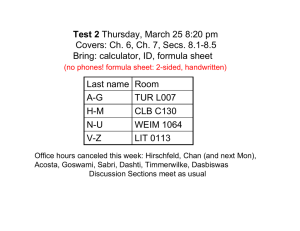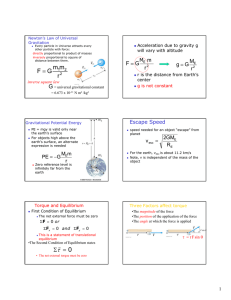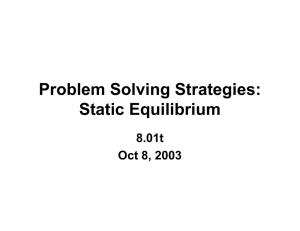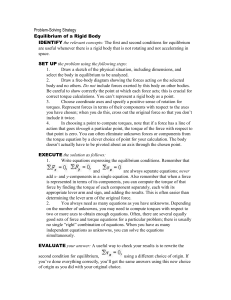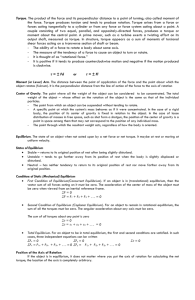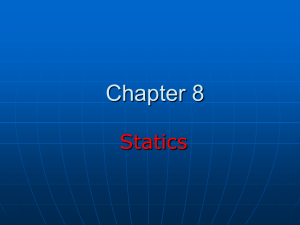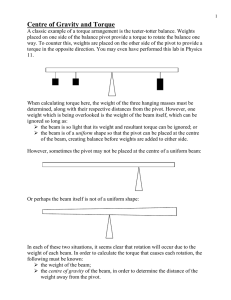9.1,2,3
advertisement
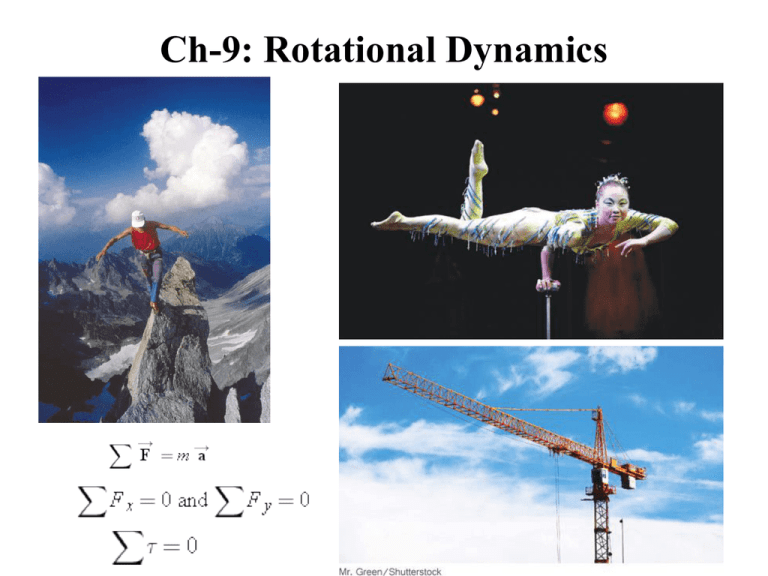
Ch-9: Rotational Dynamics Translational and Rotational Motion Torque Which one of the above application of force, F is the easiest to open a door? Definition of Torque Torque is a vector quantity. Direction: The torque is positive when the force tends to produce a counterclockwise rotation about the axis, and negative when the force tends to produce a clockwise rotation. SI Unit of Torque: newton · meter (N · m) Line of action and Lever arm The Achilles Tendon Figure 9.4a shows the ankle joint and the Achilles tendon attached to the heel at point P. The tendon exerts a force 720 N, as Figure 9.4b indicates. Determine the torque (magnitude and direction) of this force about the ankle joint, which is located away from point P. Problem 3 You are installing a new spark plug in your car, and the manual specifies that it be tightened to a torque that has a magnitude of 45 N.m. Using the data in the drawing, determine the magnitude F of the force that you must exert on the wrench. Equilibrium Of A Rigid Body A rigid body is in equilibrium if it has zero translational acceleration and zero angular acceleration. In equilibrium, the sum of the externally applied forces is zero, and the sum of the externally applied torques is zero: Applying the Conditions of Equilibrium to a Rigid Body 1.Select the object to which the equations for equilibrium are to be applied. 2.Draw a free-body diagram that shows all the external forces acting on the object. 3.Choose a convenient set of x, y axes and resolve all forces into components that lie along these axes. 4.Apply the equations that specify the balance of forces at equilibrium: SFx = 0 and SFy = 0. 5.Select a convenient axis of rotation. Identify the point where each external force acts on the object, and calculate the torque produced by each force about the axis of rotation. Set the sum of the torques about this axis equal to zero: St = 0. 6.Solve the equations for the desired unknown quantities. Problem 12 The drawing shows a person, weight = 584 N, doing push-ups. Find the normal force exerted by the floor on each hand and each foot, assuming that the person holds this position. Problem A shop sign weighing 220 N is supported by a uniform 120-N beam as shown below. 1. Draw a free-body diagram for the beam, showing all the forces acting on the beam. 2. Break the tension in the guy wire into horizontal and vertical components. 3. Write down two equations by balancing the forces in x and y directions. 4. Write down the torque equation. 5. Find the tension in the guy wire and the horizontal and vertical forces exerted by the hinge on the beam. Center of Gravity/Mass The center of gravity/mass of a rigid body is the point at which its weight/mass can be considered to act when the torque due to the weight/mass is being calculated. Example 6 The Center of Gravity of an Arm The horizontal arm in Figure 9.11 is composed of three parts: the upper arm (weight W1 = 17 N), the lower arm (W2 = 11 N), and the hand (W3 = 4.2 N). The drawing shows the center of gravity of each part, measured with respect to the shoulder joint. Find the center of gravity of the entire arm, relative to the shoulder joint. Overloading a Cargo Plane (b) Correctly loaded (c) Incorrectly loaded


